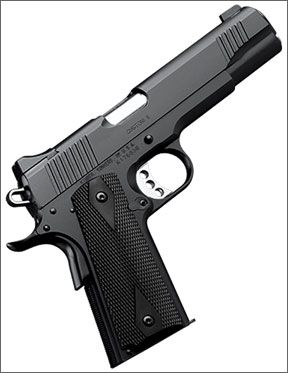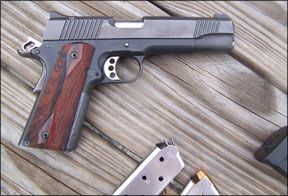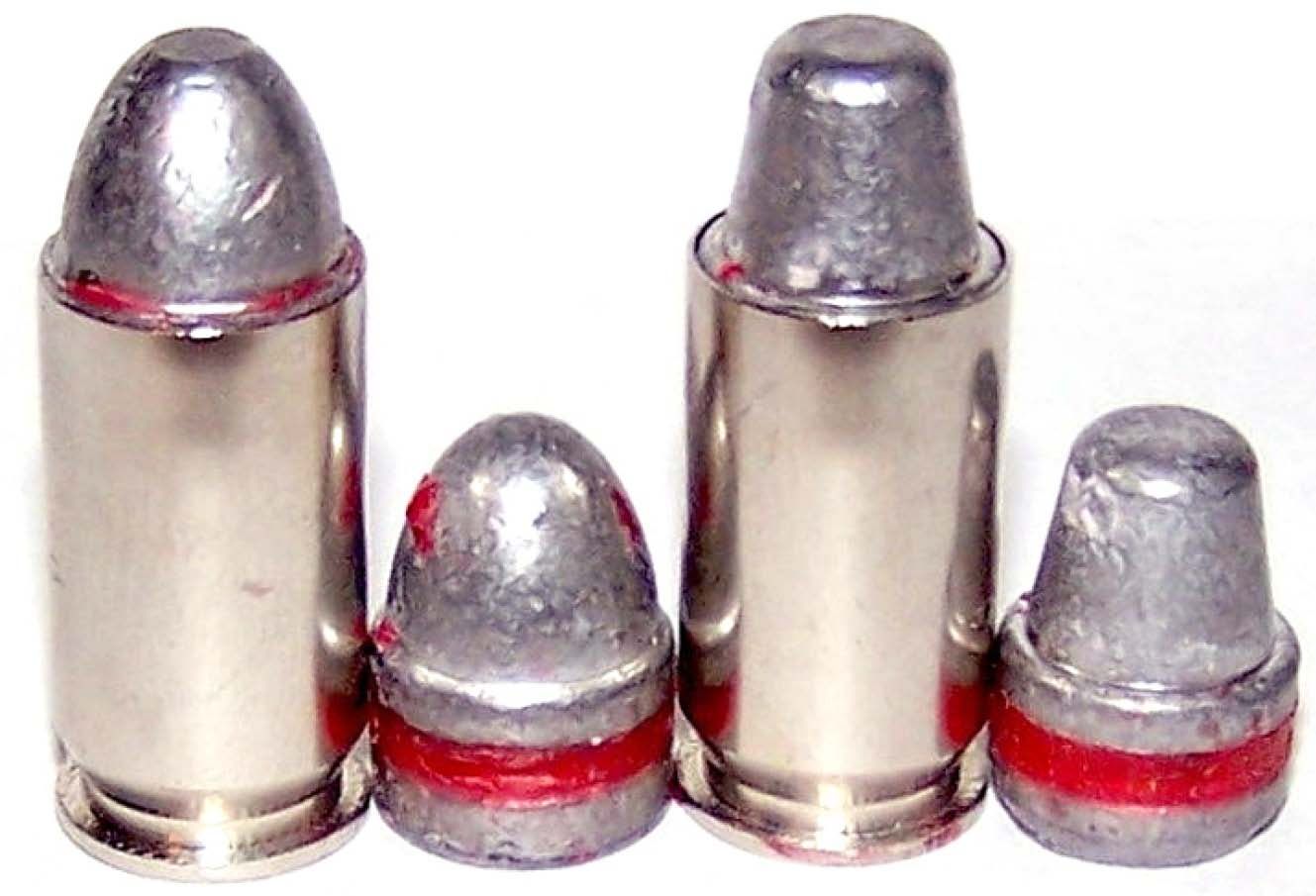In our May 2010 review of pistols suited for Cowboy Action’s widely popular new Wild Bunch side match, we noted two different categories of 1911s eligible to compete. There are two SASS classes set forth for 1911 handguns, which roughly correlate to the traditional and modern single-action class.

In our first review of handguns suited for the SASS Wild Bunch category—named in deference to the Sam Peckinpah movie, The Wild Bunch—we covered five traditional GI-type handguns from Springfield Armory, High Standard, and Colt. Prices ranged from $500 to $1000, a fairly large spread. The Springfield pistols included the GI Model, a stainless GI, and the Mil-Spec. The High Standard pistol was the 1911A1, and the Colt, the 1918 Black Army.
Recapping those guns, we said the Springfield Armory GI PW9108LP 45 ACP, $643, was the archetypical Wild Bunch pistol, meeting the rule specifications to a “T”. The pistol features fixed sights, standard controls, and checkered plastic grips. We gave it a B+. Next, the Springfield Armory Stainless GI PW9151LP 45 ACP, $693, was identical in features to the Parkerized GI pistol reviewed above. For a modest additional cost, the stainless GI pistol offers an excellent appearance. Our testers said it was easily the best-looking handgun in the matchup. Still, it scored a C grade based on its poor accuracy and initial malfunctions. The third Springfield was the company’s Mil-Spec PB9108LP Parkerized 45 ACP, $753, which earned an A grade and a Best Buy recommendation for its superb accuracy and flawless function.
The two non-Springfield guns were the High Standard 1911A1 HSTX1911 45 ACP, $480, a ‘B’-rated gun, which we said was not the best-finished pistol, but it worked and gave adequate accuracy. Last was a Colt Black Army 1918 No. 01018 45 ACP, $1000, the most expensive pistol tested, which also earned an A grade and was our team’s favorite.

The “modern” class of 45s we test this month nods to the notion that quite a few SASS members probably already own such a handgun, and interested shooters from other disciplines may jump in to shoot Wild Bunch matches. The handguns legal for use in this category are middle-of-the-road pistols. High-visibility sights without night inserts are allowed and so are forward cocking serrations and full-length guide rods. Checkered grip straps are not allowed. Your Springfield TRP and Kimber Gold Match are not legal. We eliminated a number of capable 1911 handguns in the same price range because of the frame checkering and stippling limit. Getting something for free is an advantage, but in this case the advantages were “illegal” for competition.
Our Kimber entry was the Custom II 45 ACP, $828, which has been available for more than a decade and remains an excellent buy among 1911 handguns. Set against it was the Para Ordnance PXT 7.45 45 ACP, $986, and another Springfield, the Loaded Model PX9109LP 45 ACP, $1035.
Since SASS rules demand lead bullets running at less than 1000 fps, our test program for these guns was different. Personal defense was not a consideration, and neither was jacketed hollowpoint bullet performance. The choices among factory ammunition are limited. From Black Hills, we chose a 230-grain roundnose lead load and a 200-grain semiwadcutter. Then we worked up a handload using the Oregon Trail 200-grain semiwadcutter over 5.5 grains of WW 231, a proven accuracy load. It was essential each handgun perform well with these typical match loads.
In the previous test, all of the GI pistols and the modern Loaded Model in this test were Series 70 types, with no firing pin block, although the Springfield pistols offer a lightweight firing pin and extra power spring. Among the modern guns this round, the Para Ordnance is a Series 80-type pistol with a positive firing pin block, and the Kimber Custom II uses the Schwarz-type firing pin block.
We don’t think that obtaining an original-period Colt 1911 is the best route to compete in SASS’s Wild Bunch matches. They are expensive, with the cheaper samples beginning at $1000. The older pistols were of softer steel than we use today, and commonsense tells us a shooter pistol from the era is probably well worn.
Here’s what we learned about the second round of Wild Bunch guns:
Springfield Loaded Model PX9109LP 45 ACP, $1035
The Loaded Model was more than a GI pistol with good features. The pistol featured Novak sights, an ambidextrous slide lock safety, a full-length guide rod, forward cocking serrations, and checkered wood grips. All controls were clear and crisp in operation.

The trigger showed a compression of 5 pounds and our testers commented on its smooth feel. There were no malfunctions of any type during firing. The sights were well regulated for elevation with the 230-grain load, but windage was off by several inches. We loosened the set screw in the Novak sights and carefully bumped the sights to the right until the sights were on the bull’s eye. Accuracy was credible, with groups ranging from 2 to 3 inches.
Our Team Said: We were able to purchase this pistol at a considerable discount in a popular shop, for $840. In our view, the best buy for the money is the Kimber, but it’s a close call between the Custom II and the Loaded Model. Our testers preferred the Kimber, but we realize some shooters will be just as happy with the Springfield Loaded.
Para Ordnance PXT 7.45 Sterling Edition 45 ACP, $986
The most expensive pistol tested, the Para Ordnance was a “Sterling Edition,” with the slide finished in a special bright stainless and black combination. The sights were smaller than either the Kimber or the Loaded Model, but adequate for the task. The pistol did not have forward cocking serrations.
Trigger compression was a tight 5 pounds. The sights were not well regulated for 230-grain ball, with these loads striking 3 inches low at 25 yards. A bit of file work would be necessary to get these loads on target.
The Para Ordnance has the advantage of the Power extractor, a modern extractor with 50% more gripping area.
The PXT was accurate enough, with groups ranging from 3 to 3.5 inches. A mild aggravation was the fact that the magazine spring and follower were on the tight side. However, this is not a fair criticism for Wild Bunch side matches. Its padded magazines would also have to be set aside. We used flush-fitting Metalform magazines during the test with excellent results and no problems with the magazine locking too forcefully into the slide lock.
Our Team Said: The Para Ordnance is a reliable and accurate handgun, but minor complaints reduced its grade somewhat. It’s also not listed in the current Para catalog, so it’ll take some shopping to find one.
Kimber Custom II 45 ACP, $828
The Kimber Custom II rocked the world on its heels almost 15 years ago, and it is still a popular 1911 handgun. The Custom II features high visibility sights, an extended slide lock safety, rubber grips, a full-length guide rod, and good fit and finish, our examination showed.
Our pistol is finished in Kimber’s Kim Pro. Many shooters favored the bold sight picture offered by the Kimber. Trigger compression was a smooth 4.25 pounds. Not surprising, the Custom II came out of the box running with no malfunctions. The only hitch with the Custom II was the rubber grip panels. To comply with Wild Bunch rules, we added a set of Smith & Alexander wooden grips we had on hand.
The sights were well regulated for 230-grain ball, and our team found the Kimber was accurate, shooting the best 25-yard group average in the test, under 2 inches.
Our Team Said: The primary advantage of the Kimber is in accuracy, and our team also preferred the feel of the Kimber pistol over the high-rated Springfield Loaded rated below. The Kimber is a good handgun and happened to be the least expensive pistol tested among modern 1911s. With some distributors offering ‘dealer specials’ at this time, the Kimber looks good when the price between the Kimber and the Loaded Model are similar. The Kimber will need wooden grips, and you may pay as little or as much as you wish to customize the pistol with proper grips. Testers made it Our Pick of the modern guns.
0710-SPRINGFIELD-LOADED-MODEL.pdf





























